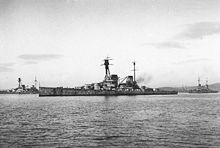Derfflinger-class battlecruiser
The preceding Moltke class and the incrementally improved Seydlitz represented the end of the evolution of Germany's first generation of battlecruisers.
Rear Admiral Ludwig von Reuter, who was in command of the interned High Seas Fleet, ordered the ships to be scuttled in an attempt to prevent their possible seizure by the Royal Navy.
Admiral Alfred von Tirpitz used public outcry over the British involvement in the Agadir Crisis of 1911 to pressure the Reichstag into appropriating additional funds to the Navy.
The Fourth Naval Law secured funding for three new dreadnoughts, two light cruisers, and an extra 15,000 officers and men in the Navy for 1912.
[3] When design work began, the navy department was asked to submit new requirements to fix deficiencies found in the preceding battlecruiser classes, which primarily covered propulsion systems and the main armament.
This would substantially increase the cruising range, and would ease the transfer of fuel and reduce the number of crew needed to operate the ships' machinery.
Since the German battlecruisers were intended to fight in the line of battle, their armament needed to be sufficiently powerful to penetrate the armor of their British opponents.
[5] On 1 September 1910, the design board chose the 30.5 cm, to be mounted in four twin turrets on the centerline of the ship.
The Derfflingers carried smaller craft, including one picket boat, three barges, two launches, two yawls, and two dinghies.
Hindenburg's power plant was rated at 71,015 shp (52,956 kW) at 290 rpm, for a top speed of 27 knots (50 km/h; 31 mph).
[11] The ships were designed to carry a secondary armament of fourteen 15 cm (5.9 in) SK L/45 guns, mounted in casemates along the superstructure.
[15] The Derfflinger-class ships were protected with Krupp cemented steel armor, as was the standard for German warships of the period.
A 45 mm (1.8 in) thick torpedo bulkhead ran the length of the hull, several meters behind the main belt.
The other two ships were to intended to replace obsolete vessels; Lützow was ordered as Ersatz Kaiserin Augusta for the elderly protected cruiser Kaiserin Augusta and the contract for Hindenburg was issued under the provisional name Ersatz Hertha, to replace the protected cruiser Hertha.
[16] She was commissioned into the High Seas Fleet on 1 September 1914, shortly after the outbreak of World War I. Lützow was built at the Schichau dockyard in Danzig under construction number 885, at the cost of 58 million gold marks.
Repair work was completed by 16 February, but Derfflinger's starboard turbine was accidentally damaged on 28 June, and the ship was again in the dockyard until August.
At 16:26, HMS Queen Mary sank after a magazine explosion that tore the ship apart; she had been targeted with a hail of heavy-caliber gunfire from Derfflinger and Seydlitz.
Her crew suffered 157 men killed and 26 wounded, which was the highest casualty figure for any German ship not sunk.
[18] Following the German capitulation in November 1918, Derfflinger was interned with a significant portion of the High Seas Fleet in Scapa Flow.
On 21 June 1919, with the guard ships of the Royal Navy out on maneuvers, Rear Admiral Ludwig von Reuter ordered that the fleet be scuttled.
On 25 October, while still running sea trials, Lützow's port low pressure turbine was severely damaged.
The following day, on 23 April, Lützow, along with her sister Derfflinger and the battlecruisers Seydlitz, Moltke, and Von der Tann, bombarded Yarmouth.
While en route to the target, Vice Admiral Franz von Hipper's flagship Seydlitz was heavily damaged by mines.
During the operation, the German battlecruisers encountered British light forces, and a running battle ensued.
[21] At the Battle of Jutland, she was the first ship in the German line, and Hipper's flagship, and drew fire from the British battlecruisers which included hits below her waterline.
[23] The crew was picked up by four torpedo boats that had been escorting the crippled battlecruiser; during the battle the ship suffered 116 men killed.
The raid was brief; by the time Hindenburg and Moltke arrived on the scene, the British ships had broken off the attack and withdrawn.
[f] On 23 April 1918, the ship took part in an abortive fleet advance into the North Sea that attempted to intercept an Allied convoy.
Moltke sustained mechanical damage while en route, and as a result, Vice Admiral Hipper decided to cancel the operation.
Rear Admiral Ludwig von Reuter replaced Hipper as the commander of I Scouting Group; he raised his flag on Hindenburg the following day.






